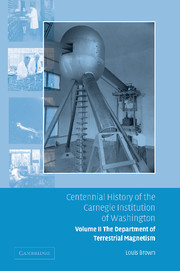Book contents
- Frontmatter
- Contents
- Foreword by Richard A. Meserve
- Preface
- 1 Establishment
- 2 Cruises and war
- 3 Expeditions
- 4 Measurements: magnetic and electric
- 5 The Fleming transition
- 6 The last cruise
- 7 The magnetic observatories and final land observations
- 8 The ionosphere
- 9 Collaboration and evaluation
- 10 The Tesla coil
- 11 The Van de Graaff accelerator
- 12 The nuclear force
- 13 Fission
- 14 Cosmic rays
- 15 The proximity fuze and the war effort
- 16 The Tuve transition
- 17 Postwar nuclear physics
- 18 The cyclotron
- 19 Biophysics
- 20 Explosion seismology
- 21 Isotope geology
- 22 Radio astronomy
- 23 Image tubes
- 24 Computers
- 25 Earthquake seismology
- 26 Strainmeters
- 27 The Bolton and Wetherill years
- 28 Astronomy
- 29 The solar system
- 30 Geochemistry
- 31 Island-arc volcanoes
- 32 Seismology revisited
- 33 Geochemistry and cosmochemistry
- 34 The Solomon transition
- 35 The support staff
- 36 Epilogue
- Notes
- Index
24 - Computers
Published online by Cambridge University Press: 06 January 2010
- Frontmatter
- Contents
- Foreword by Richard A. Meserve
- Preface
- 1 Establishment
- 2 Cruises and war
- 3 Expeditions
- 4 Measurements: magnetic and electric
- 5 The Fleming transition
- 6 The last cruise
- 7 The magnetic observatories and final land observations
- 8 The ionosphere
- 9 Collaboration and evaluation
- 10 The Tesla coil
- 11 The Van de Graaff accelerator
- 12 The nuclear force
- 13 Fission
- 14 Cosmic rays
- 15 The proximity fuze and the war effort
- 16 The Tuve transition
- 17 Postwar nuclear physics
- 18 The cyclotron
- 19 Biophysics
- 20 Explosion seismology
- 21 Isotope geology
- 22 Radio astronomy
- 23 Image tubes
- 24 Computers
- 25 Earthquake seismology
- 26 Strainmeters
- 27 The Bolton and Wetherill years
- 28 Astronomy
- 29 The solar system
- 30 Geochemistry
- 31 Island-arc volcanoes
- 32 Seismology revisited
- 33 Geochemistry and cosmochemistry
- 34 The Solomon transition
- 35 The support staff
- 36 Epilogue
- Notes
- Index
Summary
Computers were a vital component of the Department from the moment of its formation, but they were human beings, not machines, usage of the term having changed over the years (Fig. 24.1). They spent their days at mechanical devices capable of the four arithmetic operations surrounded with a generous supply of mathematical tables. But it is only the electronic computer that comes to mind now when that word is used, and it is the electronic computer that has done more to change the way in which the Department goes about its daily tasks than any other single thing during the past century.
From the vacuum-tube circuits of the 1946 ENIAC came the first commercial computer, UNIVAC, its first model sold to the Census Bureau in summer 1951. The cost of these and the rivals that soon appeared were beyond the means of the Department, which had no research at the time that demanded such unheard-of computing power, but the 1950s established that there was a strong market for computers and IBM, after a successful try with their IBM 650, decided to exploit the transistor and announced a small machine for businesses in 1959 followed shortly by the IBM 1620, which had stored-program architecture and was intended for scientific work. Pressures to buy a computer during the early 1960s grew in the Department among the seismologists, who had experienced the value of such a machine in 1961 when computing travel times from models of the Earth's crust for the Gulf of Maine data.
- Type
- Chapter
- Information
- Centennial History of the Carnegie Institution of Washington , pp. 183 - 186Publisher: Cambridge University PressPrint publication year: 2005
- 1
- Cited by



